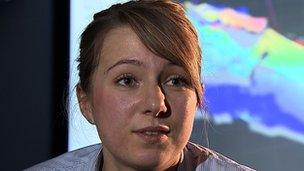Prices and technology drive 'dash' for North Sea Gas
- Published
The BBC's Simon Newton reports from the Babbage gas platform in the Southern North Sea
It was a shutdown that exposed just how reliant on gas energy Britain is.
Last Friday's temporary closure of the UK-Belgian Interconnector, one of the country's biggest import pipelines, pushed prices to an all-time high and sparked fears the nation could run out of gas.
This week BBC Look East has been given exclusive access to the Babbage gas platform in the Southern North Sea to find out more about the so-called "dash for gas".
Standing 330ft (100m) tall, the three-storey platform sits in the Babbage gas field 55 miles (88km) off the East coast.

The Babbage platform sits 55 miles (88 km) off the East coast
Operated by E.ON and named after 19th Century mathematician and inventor Charles Babbage, it cost £400m to build and is one of 153 oil and gas installations in the southern sector.
For E.On it is a huge investment, but with prices so high the rewards are immense. Babbage should pay for itself long before the field runs dry in 30 years' time.
Gas was first discovered here in the 1960s. Many thought renewable energy would eclipse it but gas still accounts for a third of UK consumption.
Surgical precision
This revival in the Southern North Sea is being driven by booming prices and new technology. Together they mean previously uneconomic fields are now viable.
The Babbage gas field lies two miles (3km) below the sea bed, trapped inside layers of porous sandstone.
In the past it was uneconomic to extract these sorts of fields - the pressure too low, the cost too high.
But directional drilling means these reservoirs can now be reached with almost surgical precision, with seismic data used to literally steer the drill towards the gas.
Meanwhile, the whole process can now be watched in real-time by a team of engineers and scientists at E.ON's headquarters in London.

Geologist Azra Kovac is part of a team that closely monitors drilling
"The margin for error is slim," explained Azra Kovac, a Croatian-born geologist with E.ON.
"Our target reservoir is only around 50ft thick. When the new data comes in we have to update continuously - almost every hour - and we need to have a good idea of where we are in the reservoir.
"If things change we need to tell the drillers quickly so they can change the well path."
The use of hydraulic fracturing or "fracking" is also allowing companies like E.ON to find new reserves deep beneath the sea.
On land, fracking remains controversial, but it has been used offshore for many years.
By pumping high-pressure chemicals and tiny ceramic pellets called proppant into the rock, seams of sandstone are opened up, allowing the trapped gas to escape.

A team of 20 men work on Babbage at any one time
'Name your price'
"Babbage is what we call a tight reservoir. The volume is high but the rock characteristics make it difficult to access," explained Kenneth McIntosh, E.ON's frack team leader.
"Fracking allows us to access much greater areas. Instead of drilling a long hole that's, say, six inches wide, you can drill a hole and by hydraulic fracking you can open up massive fractures and fissures that are three to 400ft long.
"They're very narrow but the surface area is magnitudes higher than by conventional techniques. So that reservoir becomes economic to produce."
A crew of 20 men live and work on Babbage, flying out from Great Yarmouth on alternating two-week shifts.
The lifestyle can be hard on family life. Many are on their second, or even third marriage. But this is lucrative work, particularly for those with scarce trades.
"If you're an instrument technician, you can basically name your price," said one engineer.
- Published22 March 2013
- Published15 March 2013
- Published14 January 2013
- Published11 December 2012
- Published25 October 2012